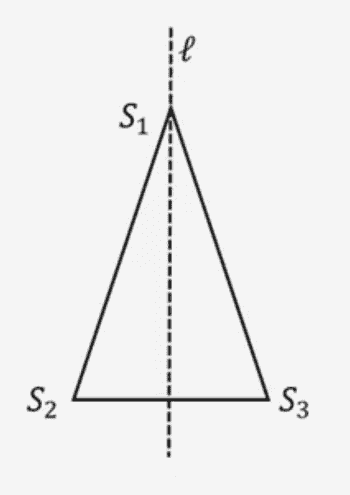7.Permutation group
7.Permutation group
Overview
Review the definition of symmetry group:
Let
Why is it called a symmetric group? This is because such groups describe the symmetry of objects. - In nature and real life, many objects have symmetry, such as isosceles triangles, squares, and regular polyhedra in geometric shapes. The symmetry of these shapes can be described as a transformation in the plane or space where the image of the shape coincides with itself.
For example:
For the isosceles triangle below, if it is flipped along the axis of symmetry, there are two types of transformations:
Identity transformation:
Reflection transformation:
Thus,

The roots of equations also have symmetry. For example, the two complex roots
Where is the symmetry reflected? Create a permutation
Both expressions are identical. This is the symmetry of the equation's roots.
Definition
Every subgroup of the symmetric group is called a transformation group on
When
Any subgroup of
A transformation group is actually a group composed of transformations, for example, if every element of a symmetry group is a transformation, then every element of its subgroup is also a transformation. However, not every subgroup of a group composed of transformations is a transformation group, because to satisfy closure, the elements of the group cannot change after the transformation. Then only the subgroups of the permutation group satisfy this requirement.
Transformation
When
Since
Thus, $$ \sigma \tau = \begin{pmatrix} 1 & 2 & 3 & 4 \ 4 & 3 & 2 & 1 \end{pmatrix}, \quad \tau \sigma = \begin{pmatrix} 1 & 2 & 3 & 4 \ 4 & 2 & 3 & 1 \end{pmatrix}. $$ (This uses right-composition here.)
See this article for details.
Cycles and transpositions
A permutation can be expressed as a product of cycles or transpositions.
Let
(1)
(2)
Then
For example, in
So
Decomposition of permutation
Find the cycle decomposition and a transposition decomposition of the following permutations.
The 6 is called the fixed point and can be omitted in the alternate resolution.
Parity of permutations
Let
In other words, what you get by swapping an odd number of times is an odd permutation.
The product of two even permutations is still an even permutation, the product of two odd permutations is also an even permutation, and the product of an even permutation and an odd permutation is an odd permutation.
The number of odd permutations in the symmetric group
All even permutations in
The identity element of
Type of permutation
Let
For example,
dihedral group
Consider the rotations or reflections of a regular
Each rotation or reflection corresponds to a permutation of its set of vertices. The product of two permutations is a rotation or reflection followed by another rotation or reflection. The inverse of a rotation or reflection is its opposite rotation or reflection.
All rotations or reflections form a group, which is a subgroup of the symmetric group
Cayley's theorem
Let
(1)
(2) If
Example:
Find the permutation group isomorphic to the Klein four-group. Solution: Given the Klein four-group
The reason why
Using
